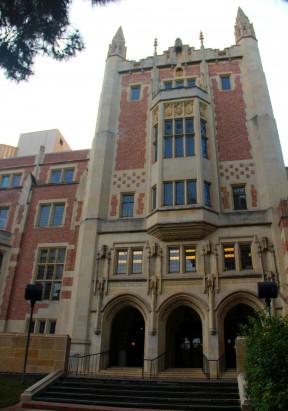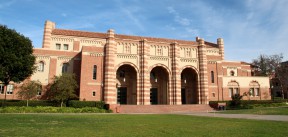When the Northridge earthquake rocked Los Angeles on Jan. 17, 1994, damaging or destroying thousands of buildings throughout the region, UCLA was nearly a decade into a seismic safety construction retrofit program.
Using previous temblors as catalysts, the program was an intensive effort to bring campus buildings up to the latest standards and increase safety for building occupants. Spurred by the Northridge temblor, UCLA expanded the program, piecing together funding from multiple sources, such as the Federal Emergency Management Agency, state and University of California bond funding, private donations and campus resources.
When all of the work is completed in 2019, a total of 66 buildings — nearly 10 million square feet worth — will have been made seismically safer. The total cost: $2.2 billion.
“Since 1985, assuring the structural safety of campus buildings has been one of our top priorities,” said Steve Olsen, UCLA’s vice chancellor and chief financial officer, who oversees the capital programs unit, which manages the work. “Seismically strengthening such a large number of buildings has been a complex and difficult task. Despite the challenges, we are now nearing completion of the work and are incredibly proud of the results.”
To date, 49 campus-owned buildings and structures — from historic buildings to residence halls and parking structures — have undergone work to make them more earthquake resistant. Work on 10 structures is currently in progress, with seismic mitigation on seven remaining buildings to be completed in the next six years.
Among the buildings that have been made seismically safer are some of the campus’s most venerable structures. Royce Hall was closed for months after the Northridge temblor cracked both of its towers. Four spires atop Kerckhoff Hall rotated six inches in the shaking and had to be removed, fixed and replaced by cranes. Powell Library was also retrofitted and the historic ceiling of its reading room was renovated and replaced.
When the Northridge earthquake hit, seismic work at Bunche and Dykstra halls and the Mathematical Sciences Building had already been completed; however, the disaster helped identify and reclassify other UCLA buildings that needed attention and reinforcement. Additional state and federal funding that became available after Northridge laid the groundwork to enhance the seismic safety program.
“It has been a very aggressive plan,” said Peter Hendrickson, associate vice chancellor for design and construction. “We have invested more and done more than any other UC campus.”
Advances in technology added to the precision of the work, Hendrickson said. Experts are now able to produce computer models that predict specific buildings’ responses to seismic activity, which has led to more accurate recommendations. Also, the U.S. Geological Survey began providing site-specific information that engineers used for seismic retrofitting and new construction.
Finding value in damaged assets
The seismically deficient south tower of the Center for Health Sciences formerly housed the UCLA Medical Center. The structure was preserved rather than demolished, thanks to the USGS recommendations.
“Rather than tearing it down and losing an asset, a better way of approaching the situation was to renovate,” said UCLA Campus Architect Jeffery Averill.
Although the damaged, 449,000 square foot building could no longer meet California’s new seismic standards for hospitals, it could be retrofitted for non-hospital use. “With the upgrades and the state funding for the south tower, the old hospital is currently being strengthened and converted to state-of-the-art research laboratory space,” Averill said.
The first phase of that project, now completed, involved the addition of 29 new concrete shear walls that required workers to dig 20 feet below the basement level to form new foundations. New building infrastructure, energy-efficient windows and finishes are currently being installed. Future renovations in other CHS buildings will include applying a fiberglass mesh wrap to strengthen critical columns and shear walls, which will improve the seismic performance of the building’s structural system.
The domino effect
The damage sustained by the south tower in 1994 paved the way for the creation of the Ronald Reagan UCLA Medical Center, which opened in 2008. To provide a site for the new hospital, a parking structure was demolished — the parking spaces that were lost were replaced by the new Parking Structure 7, located underneath the Intramural Field, Averill said.
And the quake’s effect on the campus landscape didn’t end there.
The Kinross Building, built as a temporary “staging” structure for campus departments whose buildings were being demolished or renovated, now houses the Office of Intellectual Property and the graduate student gym and lounge. Part of Hershey Hall, which was also used as a staging site, was torn down to make way for the Terasaki Life Sciences Building, which opened in 2010. The former campus police station, which was seismically deficient, was replaced with a new and improved building. And the Engineering I building was demolished, making way for the construction of Engineering VI, which is now underway.
“We’ve done everything possible to rehabilitate historic structures, like Royce and Hershey halls, to bring them back to safe, useful spaces with modern utilities, while preserving their historical fabric and integrity,” said Bill Coleman, assistant director of capital planning and finance. “In regard to other buildings like the former Dickson Art Center, which was transformed into the Eli and Edythe Broad Art Center, and the former women’s gymnasium, which became Glorya Kaufman Hall, we leveraged the state-funded seismic mitigation work, along with donor funds, to create some brand-new facilities within the older structures.”
Among the structures that have been recently built or renovated, or are currently being built, to modern seismic safety codes are graduate student and undergraduate housing facilities, Robin and Albert Carnesale Commons, Pauley Pavilion, the Meyer and Renee Luskin Conference and Guest Center, the Evelyn and Mo Ostin Music Center and the Teaching and Learning Center for Health Sciences.
“This was no small feat,” Hendrickson said. “It’s actually quite impressive to seismically upgrade and construct new buildings at the rate that we did. As a campus community, we can now enjoy the results of that investment and the commitment we made to make our built environment safe.”
UCLA in Home Stretch of 30-Year Seismic Retrofit Project


